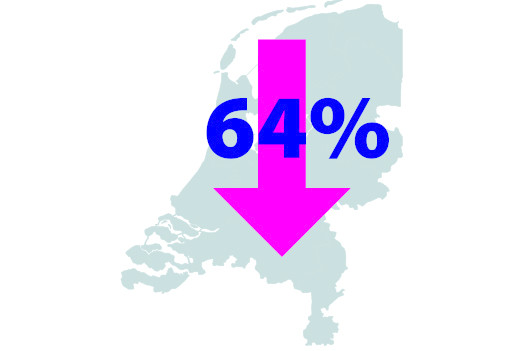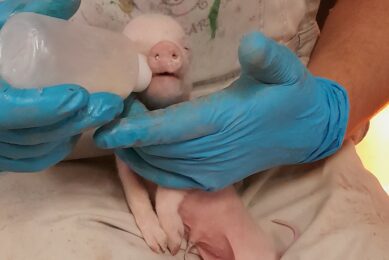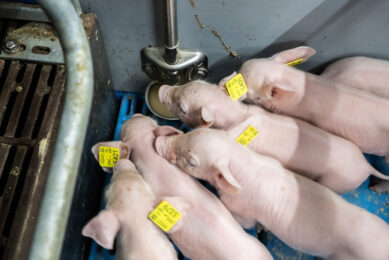Dutch antibiotic use continues to decline

In 2016, the Dutch livestock industry realised a further reduction of total antibiotics across almost all sectors. This reduction is having a positive knock-on effect on antimicrobial resistance. The annual Maran report offers the details.
The Dutch livestock sector has been aiming for maximum transparency in antibiotic use since 2011, through the monitoring of use by veterinarians and farmers. The report ‘Monitoring of antimicrobial resistance and antibiotic usage in animals in the Netherlands’, or Maran as it is better known, is produced annually by a Dutch consortium including Wageningen University. By monitoring both overall sales data at a national level and usage data per animal species, it offers an insight into the trends in the exposure of farm animals to antibiotics. The results of the study, used by the Ministry of Economic Affairs, Agriculture and Innovation for policy evaluation, also play a role in interpreting trends in antimicrobial resistance.
Monitoring of antibiotic use in the Netherlands is carried out in three ways. First, FIDIN, the federation of the Dutch veterinary pharmaceutical industry, annually reports the overall sales of antibiotics. Second, Wageningen University and Research monitors the antibiotic use per animal species, on a stratified sample of farms and thirdly, the large animal production sectors recently implemented centralised registration systems, monitoring the use on all farms.
Significant drop in antibiotic use
According to the most recent report published in June 2017, sales of antimicrobial veterinary medicinal products in the Netherlands during 2016 totalled 176 tonnes. This is a 15% reduction compared to 206 tonnes in 2015. In relation to 2009, the index year used by the Ministry of Economic Affairs, the total sales in 2016 have decreased by 64.4% (see Figure 1).
To make yearly comparisons easier, antibiotic use in the Netherlands is measured in Defined Daily Doses Animal (DDDAnat). Since 2011, husbandry related consumption reports are prepared by the Netherlands Veterinary Medicines Authority (SDa) using consumption data from all farms in the largest sectors of food production animals: pigs, veal calves, broilers, turkeys (since 2013) and cattle (since 2012). While the calculation method for treatable body mass (numerator) is the same, totalised for all farms per sector, the denominator represents the whole sector, and this measure is referred to as DDDAnat. In Table 1 the resulting DDDAnat are shown. In all but one of the sectors monitored (veal calves, dairy cattle, pigs, broilers and turkeys) a reduction in consumption was realised. Only cattle noted an increased antibiotic consumption, but this was relatively low.
Looking at the type of antibiotics in use, the report shows that most classes of antibiotics showed a decrease in sales in 2016. However, increased sales (total for all species) were noted for 1st and 2nd generation cephalosporins (+12%), amphenicols (+7%), other (+6%) and macrolides (+4%). Reductions in sales were realised for 3rd and 4th generation cephalosporins (-85%), polymyxins (-35%), tetracyclines (-24%), quinolones (-20%), aminoglycosides (-15%), fluoroquinolones (-15%), combinations (-14%), macrolides (-17%), penicillins (-15%) and trimethoprim/sulfonamides (-7%).
Resistance levels down
The reduction in total usage of antimicrobials in the Dutch livestock sector has had an effect on the resistance levels,
although for most drugs or drug classes there were notable variations in resistance levels between the different animal species. In broiler chickens, commensal E. coli isolated from caecal samples showed resistance to all commonly tested
antimicrobials. Overall, resistance levels were lower than in 2015, but the levels of resistance to ampicillin (47.0%), tetracycline (30.3%), sulfamethoxazole (40.7%), trimethoprim (36.7%) and the quinolones ciprofloxacin (41.0%) and nalidixic acid (39.30%) remained high. Cefotaxime resistance decreased from 2.5% in 2015 to 1.0% in 2016. In laying hens, resistance percentages of E. coli were substantially lower than in broilers, for all antibiotics. This is most likely a result of the difference in antimicrobial usage between the two farm types. The highest resistance percentage was observed for tetracycline (8.8%). E. coli isolates from laying hens were not tested in 2015, but compared to 2014 resistance percentages were substantially decreased (ampicilline from 13.7% to 5.2%, tetracycline from 14.2% to 8.8%, sulfamethoxazole from 5.8% to 2.6% and trimethoprim from 5.8% to 2.1%).
In terms of slaughter pigs, resistance against tetracycline, sulfamethoxazole, trimethoprim and ampicillin remained high in 2016 in E. coli isolates and was 42.8%, 34.4%, 31.8% and 23.1%, respectively. The resistance levels of these four antibiotics have showed an ongoing tendency to decrease since 2011. In 2015, a slight increase was shown for ampicillin and trimethoprim, but in 2016 resistance levels of these antibiotics were again decreased. Resistance to the 3rd generation cephalosporins was the same as in 2015 (0.3%), indicating that ESBLs are present, but in low concentrations.
Resistance in E. coli isolated from dairy cattle is very low compared to resistance levels observed in pigs, broilers and veal calves, reflecting the low use of antibiotics in this husbandry system. Resistance rates decreased compared to 2015, and overall rates remained below 2% and no resistance to 3rd generation cephalosporins were detected.
Less antibiotic use is effective
The use of antibiotics of critical importance to human health care (especially cephalosporins of 3rd and 4th generation) has been reduced to an absolute minimum in the Netherlands. This reduction in usage is reflected in the resistance data of 2016 where resistance levels decreased in E. coli from most animal species. Also the occurrence of ESBL/AmpC-producing E. coli in poultry meat was substantially lower than in previous years. This suggests that the measures to reduce the overall antibiotic use and to stop the use of 3rd generation cephalosporins have been effective in reducing ESBL/AmpC-contamination of food-products. Therefore, the ongoing reduction of antibiotic use in Dutch livestock over the past seven years reflects positively in the ongoing reduction of antibiotic resistance in animals and the food thereof.
To view the full report visit: www.wur.nl/en/Research-Results/Projects-and-programmes/MARAN-Antibiotic-usage.htm.
 Beheer
Beheer





 WP Admin
WP Admin  Bewerk bericht
Bewerk bericht